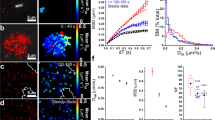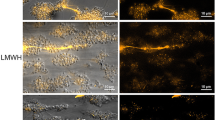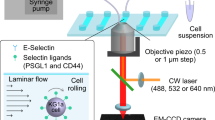Abstract
SELECTINS tether to the blood vessel wall leukocytes that are flowing in the bloodstream and support subsequent labile rolling interactions as the leukocytes are subjected to hydrodynamic drag forces1,2. To support this rolling, selectins have been proposed to have rapid bond association and dissociation rate constants, and special mechanical properties linking tensile forces and bond dissociation3-6. We have visualized transient tethering and release of neutrophils in hydrodynamic flow on lipid bilayers containing densities of P-selectin below those required to support rolling. We report here that transient tethers had first-order kinetics and other characteristics suggesting a unimolecular interaction between P-selectin and its glycoprotein ligand (PSGL-1). The unstressed dissociation constant (off rate) was 1 s-1. Hydrodynamic shear stresses of up to 1.1 dyn cm-2, corresponding to a force on the bond of up to HOpN, increased the off rate only modestly, to 3.5 s-1. The data was adequately matched by a proposed equation7 relating off rate to the exponential of tensile force on the bond and the bond interaction distance, and gave a bond interaction distance of 0.5Å. This distance is compatible with hydrogen and metal coordination bonds between P-selectin and PSGL-1. Fast on and off rates, together with the high tensile strength of the selectin bond, appear necessary to support rolling at physiological shear stresses.
This is a preview of subscription content, access via your institution
Access options
Subscribe to this journal
Receive 51 print issues and online access
$199.00 per year
only $3.90 per issue
Buy this article
- Purchase on Springer Link
- Instant access to full article PDF
Prices may be subject to local taxes which are calculated during checkout
Similar content being viewed by others
References
Lasky, L. A. Science 258, 964–969 (1992).
Springer, T. A. Cell 76, 301–314 (1994).
Lawrence, M. B. & Springer, T. A. Cell 65, 859–873 (1991).
Dembo, M., Torney, D. C., Saxman, K. & Hammer, D. Proc. R. Soc. B234, 55–83 (1988).
Hammer, D. A. & Apte, S. M. Biophys. J. 63, 35–57 (1992).
Tözeren, A. & Ley, K. Biophys. J. 63, 700–709 (1992).
Bell, G. I. Science 200, 618–627 (1978).
Goldman, A. J., Cox, R. G. & Brenner, H. Chem. Engng Sci. 22, 653–660 (1967).
Tempelman, L. A. & Hammer, D. A. Biophys. J. 66, 1231–1243 (1994).
Sako, D. et al. Cell 75, 1179–1186 (1993).
Moore, K. L. et al. J. Cell Biol. 118, 445–456 (1992).
Moore, K. L. et al. J. biol. Chem. 269, 23318–23327 (1994).
Ushiyama, S., Laue, T. M., Moore, K. L., Erickson, H. P. & McEver, R. P. J. biol. Chem. 268, 15229–15237 (1993).
Press, W. H., Flannery, B. P., Teukolsky, S. A. & Vetterling, W. T. Numerical Recipes: the Art of Scientific Computing (Cambridge Univ. Press, Cambridge, 1986).
Munson, P. J. & Rodbard, D. Analyt. Biochem. 107, 220–239 (1980).
Dowdy, S. & Wearden, S. Statistics for Research (Wiley, New York, 1985).
Erbe, D. V. et al. J. Cell Biol. 119, 215–227 (1992).
Graves, B. J. et al. Nature 367, 532–538 (1994).
Fersht, A. Enzyme Structure and Mechanism (Freeman, New York, 1985).
Erickson, H. P. Proc. natn. Acad. Sci. U.S.A. 91, 10114–10118 (1994).
Janin, J. & Chothia, C. J. biol. Chem. 265, 16027–16030 (1990).
Evans, E., Berk, D. & Leung, A. Biophys. J. 59, 838–848 (1991).
Bell, G. I., Dembo, M. & Bongrand, P. Biophys. J. 45, 1051–1064 (1984).
Kansas, G. S., Ley, K., Munro, J. M. & Tedder, T. F. J. exp. Med. 177, 833–838 (1993).
Mason, D. W. & Williams, A. F. in Handbook of Experimental Immunology Vol. I: Immunochemistry 4th edn (eds Weir, D. M., Herzenberg, L. A. & Blackwell, C.) Vol. 4, 38.1–38.17 (Blackwell, Oxford, 1986).
Kaplanski, G. et al. Biophys. J. 64, 1922–1933 (1993).
Chan, P.-Y. et al. J. Cell Biol. 115, 245–255 (1991).
Lawrence, M. B., Bainton, D. F. & Springer, T. A. Immunity 1, 137–145 (1994).
Geng, J. G. et al. Nature 343, 757–760 (1990).
Steininger, C. N., Eddy, C. A., Leimgruber, R. M., Mellors, A. & Welply, J. K. Biochem. biophys. Res. Commun. 188, 760–766 (1992).
Author information
Authors and Affiliations
Rights and permissions
About this article
Cite this article
Alon, R., Hammer, D. & Springer, T. Lifetime of the P-selectin-carbohydrate bond and its response to tensile force in hydrodynamic flow. Nature 374, 539–542 (1995). https://doi.org/10.1038/374539a0
Received:
Accepted:
Issue Date:
DOI: https://doi.org/10.1038/374539a0
This article is cited by
-
Microscopic theory, analysis, and interpretation of conductance histograms in molecular junctions
Nature Communications (2023)
-
Light-driven single-cell rotational adhesion frequency assay
eLight (2022)
-
Quantifying and controlling bond multivalency for advanced nanoparticle targeting to cells
Nano Convergence (2021)
-
Single-molecule imaging and microfluidic platform reveal molecular mechanisms of leukemic cell rolling
Communications Biology (2021)
-
Effects of domain unfolding and catch-like dissociation on the collective behavior of integrin–fibronectin bond clusters
Acta Mechanica Sinica (2021)
Comments
By submitting a comment you agree to abide by our Terms and Community Guidelines. If you find something abusive or that does not comply with our terms or guidelines please flag it as inappropriate.



